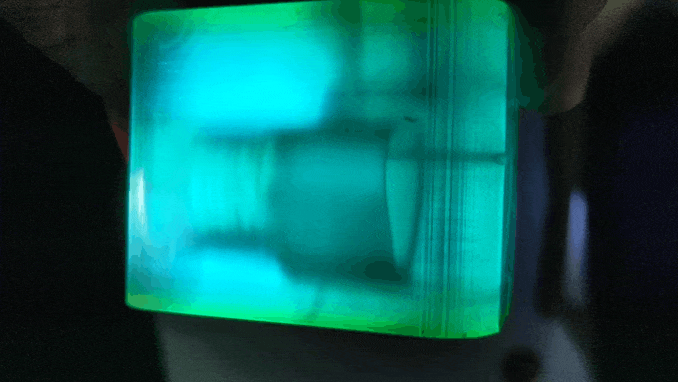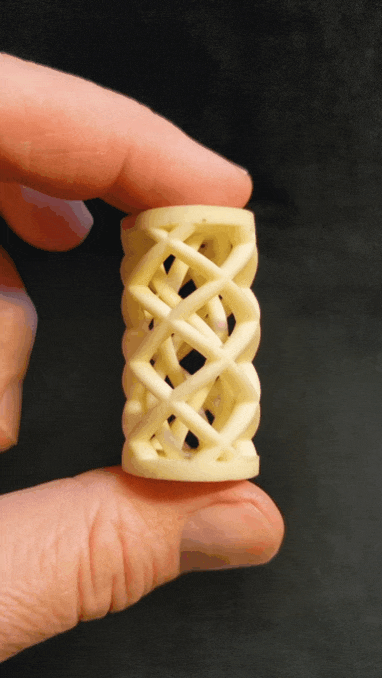Danish company AddiFab manufactures a technology it refers to as Freeform Injection Molding with which you can inexpensively 3D print molds and other soft tooling. Just recently, the firm set up a service together with Mitsubishi Chemical. Now, they’re working together with German firm CADENAS and its GEOSeach tool. The two companies hope to use GEOSearch to allow users look for and find the ideal parts to mold. Using Geometric Similarity Search, they can compare a file to existing files in CAD libraries.

An Addifab mold with a PPS part inside.
According to the firm:
“Using the Geometric Similarity Search GEOsearch, engineers can quickly and easily search for geometrically similar components within their parts libraries, starting from a roughly designed part or a 3D sketch.
“In addition to the shape they are looking for, users can also use CADENAS’ GEOsearch to define the desired size of the printed tool in advance of the search. Because when printing with the AddiFab technology, the maximum size of 10 x 10 x 20 cm is of decisive importance. In this way, workpieces that are too large can be effectively excluded.
“Due to the significantly reduced costs of 3D printing tools in prototype development and small series production, PARTsolutions in combination with the AddiFab printing technology offers an enormous savings potential.”

I’d love for Thingiverse or other platforms to have a similar functionality. It would be great to be able to eliminate things that were too large or that were already made. Or to automatically find something for that last piece of filament or to find a figurine that fit that one empty space on your build. Geometry searches could also really help us repurpose CAD files by finding geometries that have the same functionalities. Or you could find items that feature 35-degree angles or don’t have overhangs.
Imagine that you were going to have to model a button from scratch, but the same one existed or one existed that was so similar that it could quickly be changed into the part you need. There are a lot of CAD and print files out there that could be readily repurposed into many other things. It would also be powerful to combine this with nesting software, so you could automatically fill the rest of the build with sunglasses, for example, or other relevant objects.
Or you could have a queue of objects you’d like to have. Cura could check with GEOSearch to compare the things you want to see and what can be printed “for free” in terms of time. In SLS builds, you could have a standing order of many different parts that are all printed in certain builds once they are relevant.
For Addifab this could significantly accelerate their business. This could be an excellent sales tool for them. Generally, this should make it cheaper for AddiFab to find new customers and find usable parts to print inside their parts libraries. At the same time customers could more easily perform cost analysis and selection of parts for 3D printing. Spare parts are very often seen as cost centers and receive little love from the rest of the organization on the user side. OEMs that sell spare parts generate considerable profits from them. But, they’re already locked into processes that see them fill warehouse upon warehouse of parts.
AddiFab’s idea of a digital method for producing these parts relatively inexpensively could really gain traction. Billions of dollars stored up for years in warehouses could be converted to free cash flow. Only a few spares would have to be made, of a certain type. They could then be made to order supplementally.
This idea coupled with the wide variety of materials that the company can use could see them find success in spares. But, how to get a customer started? With what parts can they even do this? This simple solution should accelerate their sales efforts and let others dream of something similar for their machines and processes. I’ve heard it so often from clients that they’re looking for a part selector or something to tell them just what percentage of their parts could be 3D printed and at what cost. A tool similar to GEOSearch could be just what a lot of salespeople in 3D printing need.
Subscribe to Our Email Newsletter
Stay up-to-date on all the latest news from the 3D printing industry and receive information and offers from third party vendors.
You May Also Like
3D Printing Unpeeled: New Arkema Material for HP, Saddle and Macro MEMS
A new Arkema material for MJF is said to reduce costs per part by up to 25% and have an 85% reusability ratio. HP 3D HR PA 12 S has been...
3D Printing News Briefs, January 20, 2024: FDM, LPBF, Underwater 3D Printer, Racing, & More
We’re starting off with a process certification in today’s 3D Printing News Briefs, and then moving on to research about solute trapping, laser powder bed fusion, and then moving on...
3D Printing Webinar and Event Roundup: December 3, 2023
We’ve got plenty of events and webinars coming up for you this week! Quickparts is having a Manufacturing Roadshow, America Makes is holding a Member Town Hall, Stratafest makes two...
Formnext 2023 Day Three: Slam Dunk
I’m high—high on trade show. I’ve met numerous new faces and reconnected with old friends, creating an absolutely wonderful atmosphere. The excitement is palpable over several emerging developments. The high...































